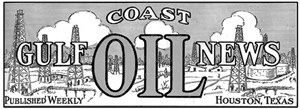Gulf Coast Oil News: First oil journal for the gulf coast
Published in September 1916 by Gulf Publishing Company, the Gulf Coast Oil News was a weekly publication devoted to covering fast-moving oil developments on the Gulf Coast, particularly Goose Creek field on the Houston Ship Channel. Daily newspapers at the time did not report in depth on oil patch news. The slogan at the top of the masthead said, “The only oil journal published in the Gulf Coast country.”
Initially, the Gulf Coast Oil News was printed as a broadsheet on newsprint. The first issue as a magazine was published on Jan. 5, 1918. A single magazine issue was priced at $0.15 at newsstands. One year’s subscription via U.S. Mail cost $4.00, with an extra dollar charge for foreign annual subscriptions.
Covering the Gulf Coast oil news. The weekly provided field-by-field statistics on the Gulf Coast oil fields—Goose Creek, Humble, Sour Lake, Saratoga, Damon Mound, etc. The information included production levels by company, plus abbreviated drilling and completion reports. “Tampico Notes” covered news from Tampico field in Mexico. Discoveries were listed in a column called “Wildcats from all sections” and downstream news was summarized in “Refinery Activities”.
The three leading companies in Goose Creek field were Gulf Production Company, Sinclair Gulf Corporation and Humble Oil Company. The total production from Goose Creek during the week of June 9-16, 1917 was 24,000 bopd.
Supporting the war effort. Gulf Coast Oil News joined a campaign launched by Houston corporate titan Jesse H. Jones to raise $100 million in support of the American Red Cross on the battlefields of Europe. Editor Dudley raised a toast to the crews of American oil tankers, “who braved death to transport petrol to France.”
Early technical articles. The U.S. Bureau of Mines, precursor to the U.S. Department of Interior, was a major source of technical articles published in the Gulf Coast Oil Weekly.
One of the first of a series of technical articles was titled “Origin and nature of accumulations of petroleum deposits” by petroleum geologist Grenville Gates Howard. Mr. Howard discounted the commonly accepted theory at the time that oil accumulated in basalt plugs. He suggested that “anticlinal folds are the real cause of accumulations of oil.”
In the June 23, 1918 issue, W. L. Hartzell, with Westinghouse Electric, wrote an article on “Electricity to speed oil well production.” Steam was used to drive drilling rigs and production equipment well into the 1950s.
In the Aug. 11, 1918 issue, Editor Dudley challenged the notion of an Eastern “oil expert” that coastal oil fields were 85% were exhausted, with an editorial titled “Deep oil, more oil”.
Covering the industry leaders. One of the popular features of the Gulf Coast Oil News was “Who’s Who and the Reason,” which introduced various entrepreneurs and leaders in the oil industry. These included Howard R. Hughes, inventor of the rotary drill bit; William A. Vinson, the lawyer who founded Houston’s leading Vinson & Elkins law firm; Harry F. Sinclair, president of Sinclair Oil & Gas; William G. Skelly, president of Skelly-Sankey Oil Company. As president of the Tulsa Chamber of Commerce, Mr. Skelly was one of the founders of the International Petroleum Exposition, which took place in Tulsa, Okla., what was then considered the oil capital of the world. ![]()

- Applying ultra-deep LWD resistivity technology successfully in a SAGD operation (May 2019)
- Adoption of wireless intelligent completions advances (May 2019)
- Majors double down as takeaway crunch eases (April 2019)
- What’s new in well logging and formation evaluation (April 2019)
- Qualification of a 20,000-psi subsea BOP: A collaborative approach (February 2019)
- ConocoPhillips’ Greg Leveille sees rapid trajectory of technical advancement continuing (February 2019)



